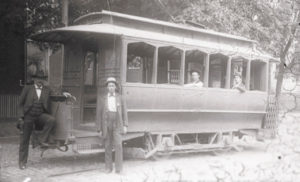 The West End neighborhood was one of the first streetcar suburbs in North Carolina designed to reflect the “picturesque” concept of suburban planning promoted on the national level by Frederick Law Olmstead. In addition, it was the first picturesque suburb in North Carolina developed according to its original design.
The West End neighborhood was one of the first streetcar suburbs in North Carolina designed to reflect the “picturesque” concept of suburban planning promoted on the national level by Frederick Law Olmstead. In addition, it was the first picturesque suburb in North Carolina developed according to its original design.
Developed at the western edge of the town of Winston, the West End was planned in 1890 by Jacob Lott Ludlow who would become a nationally-recognized municipal, sanitary and hydraulic engineer and who was Winston’s first city engineer. Ludlow’s remarkable plan of curvilinear streets and parks took advantage of the already dramatic topography of the area and formed a radical departure from the grid plans of Winston and Salem. The West End reflected Winston’s phenomenal growth period from the late 1880s through the 1920s, as tobacco and textile manufacturing reached new levels of production and Winston-Salem became North Carolina’s largest city. The economic growth of the city enabled some of its citizens to build handsome residences of the distinctive character found in the West End.
The neighborhood contains well-detailed examples of the Queen Anne, Neo-Classical Revival, Colonial Revival, and Craftsman styles. The neighborhood today is one of the most intact, fully-realized examples of a “turn of the century” streetcar suburb in North Carolina, and it has retained its system of parks and residential boulevards.
Section-8, Significance
